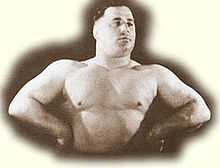Bert Assirati
| Bert Assirati | |
|---|---|
 | |
| Born | 1908 |
| Died | 31 August 1990[1] |
| Professional wrestling career | |
| Ring name(s) | Bert Assirati |
| Billed height | 5 ft 7 in (1.70 m)[1] |
| Billed weight | 250 lb (110 kg; 18 st)[1] |
| Trained by | Atholl Oakeley[2] |
| Debut | 1928[3] |
Bartolomeo "Bert" Assirati[3] (1908 – 31 August 1990), was an English professional wrestler who became a multiple time British Heavyweight Champion, and, posthumously, a member of the Wrestling Observer Newsletter Hall of Fame. He was known for displaying various feats of strength, including setting a British record in 1938 by lying on his back, and pulling over at arms length a two hundred pound barbell. At 240 pounds, Assirati was one of the heaviest men to perform the iron cross.
Career
Assirati began weight-training at the age of twelve. At the age of seventeen, Assirati formed part of the acrobatic stage duo Mello and Nello.[4] Travelling to every port they could reach, the pair performed a variety of hand-balancing acts. At the age of twenty, Assirati began his career as a professional wrestler, but continued to train as a weight-lifter. At his highest weight, he was one of the strongest men in the world, and could still perform such acrobatic maneuvres as the iron cross and a one-arm hand stand.[5] After winning matches, Assirati would perform a standing back flip.[1] In 1938, Assirati deadlifted 800 pounds.[4] He trained for his career in wrestling under Atholl Oakeley.[2]
Assirati was known as a vicious competitor. He is said to have taken pleasure in injuring his opponents, and often refused to play along with the predetermined nature of professional wrestling.[6] Many promoters were reluctant to book him, because of his reputation for double-crossing his opponents, and many wrestlers were said to be afraid to wrestle him. Assirati stated that Lou Thesz was one of the wrestlers afraid to face him. In one version of the story, Assirati challenged Thesz to a match, but Thesz refused.[3] According to Thesz's account in his autobiography, he challenged Assirati for a series of wrestling matches, but Assirati did not respond to his request. Wrestler Les Thornton stated that Assirati's eagerness to hurt people in the ring helped establish credibility for competitors who were willing to face him.[7]
Assirati won his first major championship while competing in the British Wrestling Association (BWA). He had claimed to be the British Heavyweight Champion but did not win the title officially until 27 January 1945.[8] Two years later, he also won the European version of the World Heavyweight Championship by defeating Paul Yvar Martinsen in the final round of a tournament on 18 February 1947. He later dropped this title to Martinson but continued to hold the British Heavyweight Championship.[9] To this, he added the European Heavyweight Championship in 1949 by defeating Felix Miquet. Miquet regained the title belt later that year, however.[10]
In 1950, Assirati left the British Wrestling Association to wrestle in India. As a result, he was stripped of the British Heavyweight Championship.[8] He returned to Europe and won back the European Heavyweight Championship in 1952. Once again, he left for India and was forced to vacate the title.[10] In 1955, he won his final championship by defeating Ernie Baldwin for the vacant British Heavyweight Championship. He was stripped of the title in 1958 by Joint Promotions, the governing body, although the British Wrestling Federation (BWF) continued to recognize him as their champion. In 1960, Assirati sustained an injury, and the BWF stripped him of the title as well.[8]
Later in his life, Bert worked as doorman at the Ebbisham Halls in Epsom, Surrey, especially on the dance nights when many of the top acts of the sixties were playing there. He used to enjoy showing a party trick of placing a metal drink cap between each of the fingers on both hands and completely crush them all at once.
On 31 August 1990, Assirati died of bladder cancer.[1] In 1996, he became one of the first inductees to the Wrestling Observer Newsletter Hall of Fame.[11]
Championships and accomplishments
- British Wrestling Association
- Other Titles
- Wrestling Observer Newsletter
References
- ↑ 1.0 1.1 1.2 1.3 1.4 Smith, Charles A. "Tribute to a Strength Athlete: Bert Assirati". LA84 Foundation. Retrieved 2009-12-16.
- ↑ 2.0 2.1 "Biography: The British Heavyweight Champion". BertAssirati.com. Retrieved 2009-12-16.
- ↑ 3.0 3.1 3.2 "Wrestlers: A". Wrestling Heritage. Retrieved 2009-12-16.
- ↑ 4.0 4.1 "Bert Assirati". American Powerlift Revolution. Archived from the original on 2006-01-29. Retrieved 2009-12-16.
- ↑ "Feats of Strength". BertAssirati.com. Retrieved 2009-12-16.
- ↑ "A passion for men in tights". The Yorkshire Post. 30 June 2008. Retrieved 2009-12-16.
- ↑ Oliver, Greg (20 February 2005). "Les Thornton: A life on the road". SLAM! Wrestling. Retrieved 2009-12-16.
- ↑ 8.0 8.1 8.2 8.3 8.4 8.5 "British Heavyweight Title". Wrestling Titles. Retrieved 2009-12-16.
- ↑ 9.0 9.1 "World Heavyweight Title (Europe)". Wrestling Titles. Retrieved 2009-12-16.
- ↑ 10.0 10.1 10.2 "European Heavyweight Title". Wrestling Titles. Retrieved 2009-12-16.
- ↑ 11.0 11.1 "Wrestling Observer Hall of Fame". Pro Wrestling Illustrated. Retrieved 2009-12-16.
External links
- An article on Assirati from Iron Man Magazine, July 1948 at the Wayback Machine (archived January 29, 2006)
- BertAssirati.com
- Online World of Wrestling profile